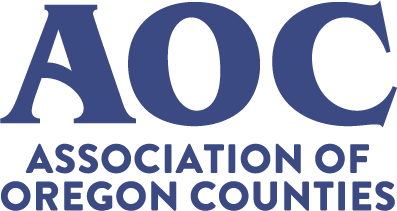
Governor’s Recommended Budget Just the Starting Point
While a lot of state agency work and stakeholder engagement by the governor’s office goes into the crafting of the Governor’s Recommended Budget (GRB), it’s important to remember that the GRB is in fact only a recommendation and could look significantly different from the Legislatively Adopted Budget (LAB) we see at the end of session. Below are brief summaries of the GRB by AOC portfolio area, with notes on potential impacts to county services and any early developments in legislative activity.
HEALTH AND HUMAN SERVICES
The GRB for the 2023-2025 biennium prioritizes housing and homelessness, behavioral health, and education. It is a good starting point for negotiating behavioral health care investments in the coming months but creates a lot of extra ground to cover to reach needed investment in local public health modernization. Intellectual and developmental disabilities services have a good starting point with a recommendation to fully fund the new rate model for the entire biennium. There is an expedited “first 60 days” emergency homelessness response package in the works, but otherwise, the health and human services budget is usually among the last to be solidified.
Behavioral Health
Key components in the GRB for behavioral health include:
- Continuation of the $1.2 billion invested by the Legislature in 2021 and 2022 for behavioral health system infrastructure improvements.
- $14.9 million General Fund for:
- Enhanced precommitment services for patients;
- A team at the Oregon Health Authority (OHA) to improve civil commitment services; and
- Expansion of jail diversion services to counties currently without it.
- Oregon State Hospital Stabilization
- $34.5 million General Fund to fund a sustainable 24/7 staffing model at the Oregon State Hospital;
- $4.2 million General Fund for the care of patients with complex psychiatric needs;
- $3.5 million General Fund for a dedicated health equity team for Oregon State Hospital (OSH) staff; and
- $10.0 million General Fund to provide evidence-based transition case management for patients who are leaving OSH houseless.
- Harm Reduction Clearinghouse – $40.0 million request from recent opioid settlements to continue support of the harm reduction clearinghouse to reduce preventable deaths associated with opioid use.
- Behavioral Health Crisis Line – $18.6 million in additional funding to support the 9-8-8 behavioral health crisis line, along with a legislative concept to require commercial payers to reimburse for mobile crisis services, and a $0.40 per line per month charge on phone lines to support 9-8-8 crisis intervention (HB 2757).
- Suicide Prevention/Intervention Services – $7.7 million General Fund to expand the child and adult suicide prevention, intervention, and postvention program to reduce suicide in Oregon.
- Behavioral Health Facility Investments
- $100 million Lottery Bond proceeds to expand acute psychiatric facilities in the community;
- $15 million General Fund for substance use disorder facilities and recovery centers; and
- $2.3 million for additional children’s psychiatric residential treatment capacity.
- Oregon Behavioral Health Coordination Center – $1.5 million General Fund to coordinate the availability of behavioral health residential beds statewide.
- Children and Youth Services – $11.5 million General Fund to support the expansion of behavioral rehabilitation services to all Medicaid clients who need it, the expansion of service hubs for transition aged-youth, and for targeted investments in the workforce for additional child psychiatrists and developmental pediatricians.
- Workforce Incentives – $20 million General Fund, nearly doubling the OHA’s Health Care Provider Incentive Program, with a priority to increase Oregon’s behavioral health workforce and to continue to recruit and retain diverse health care providers and attract providers in underserved areas.
Intellectual and Developmental Disabilities (I/DD)
“The budget fully funds the new rate model for the entire 24-month period of the biennium, using the new service groups based on the Oregon Needs Assessment and new rate model payment categories. The budget also includes funding for staffing and to secure a case management system, a universal provider portal, and a robust agency provider system to improve provider reporting capabilities and to replace the state’s antiquated system. These projects obtain a 90 percent federal match rate. The I/DD budget includes funding for two positions for cross-systems coordination with child welfare and other systems to ensure optimal services to parents with I/DD whose children receive services from child welfare and children with I/DD involved in the child welfare system. Finally, the I/DD budget includes funding and position authority for the Model Employer Program by funding a dedicated pool of positions within the Office of Developmental Disabilities Services to facilitate the hiring of people with I/DD throughout the department. The 2023-25 GRV for the I/DD program is $4,632.2 million total funds, a 9.4 percent increase from the 2021-23 LAB. The budget funds 1,005 positions.”
(Source: GRB p. 59)
Public Health
Despite the June 2022 Public Health Modernization: Funding Report to Legislative Fiscal Office detailing a conservative request for $256 million for the coming biennium and noting the continual massive underfunding of the initiative since its inception in 2015, the GRB allocates only $100 million for modernization.
Revenue Summary: “the state’s ability to provide program services is greatly influenced by Federal Funds availability and by the rules guiding the use of those funds. In addition, the rate of federal revenue matching for many programs is tied to the Federal Medical Assistance Percentage (FMAP) rate, which changes annually and is not controlled by state policy. This greatly impacts the amount of General Fund needed to maintain programs. The standard FMAP rate will decrease from 60.3 percent in 2023-25 to 59.3 percent next biennium. However, for 2023-25, there are two other primary changes to the FMAP adjustment, including the expiration of the enhanced public health emergency FMAP rate and the expiration of the enhanced Home and Community Based Services FMAP rate approved for part of the 2021-23 biennium through the American Rescue Plan Act. The combined impact from these changes results in a need for an additional $413.4 million General Fund in 2023-25. This assumes the wind down of the enhanced public health emergency FMAP rate in the first six months of 2023-25 as approved through the 2023 federal omnibus bill.” (GRB p. 55)
Key components in the GRB include (GRB p 64-65):
- Public Health Modernization –$50.0 million General Fund to sustain public health capacity to respond to emerging needs for local public health authorities, tribal governments, reproductive health providers, and community-based organizations, all to help modernize the state’s public health system. This investment includes $3.4 million to support enhanced access to reproductive health care across the state by increasing opportunities to support the health care workforce, reducing administrative barriers to participation in public programs, and improving and standardizing reproductive health reimbursement rates across OHA programs. This investment also funds the development of a statewide public health system plan to maximize upstream investments to address disparities for Black, Indigenous, and People of Color (BIPOC), and rural Oregonians.
- Universally Offered Home Visiting –$5.9 million General Fund to fund the full statewide expansion of the Universally Offered Home Visiting program for families with newborns so all parents have access to critical services, skills, and additional resources supporting healthy families.
- Lower Umatilla Basin Groundwater Mitigation –$3.0 million General Fund to address drinking water contamination in the Lower Umatilla Basin, paying for outreach, coordination, domestic well testing, and water treatment systems for affected households, as well as providing funding for statewide infrastructure for the drinking water safety program at OHA.
- Environmental Public Health – $1.0 million General Fund for a study to investigate the consumption of contaminated fish in Oregon, $0.2 million General Fund for a position focused on mapping for the Environmental Justice Council, and $0.1 million for an environmental public health inspector for Curry County.
- Personal Protective Equipment (PPE) Stockpile – $1.0 million General Fund to continue support for OHA’s stockpile of personal protective equipment, vaccines and vaccine kits, tests and testing supplies, and other medical equipment for use in response to a major disaster or public health emergency.
- Emergent Public Health Issues – $1.0 million General Fund for an investigation of contaminated fish consumption in the Lower Columbia Basin, $0.2 million General Fund for environmental justice data mapping work, and $0.1 million General Fund to support a public health investigator position in Curry County.
- Psilocybin Regulation – $6.6 million Other Funds from revenues to provide program development, regulatory oversight, and consumer protection related to the use of psilocybin.
NATURAL RESOURCES
The GRB for the 14 agencies that fall under the natural resources program area is a 12 percent reduction from the previous biennial allocated funds. A big portion of this reduction is because of the one-time funding that was allocated in 2021 and not slated to continue in 2023 ($500 million). The GRB does call for the allocation of $23.9 million for continued investments in the Private Forest Accord; it extends funding to support communities working to recover from the 2020 wildfires; funding for a water package that prioritizes data collection, drinking water, conservation efforts, and addressing agricultural needs.
Key components in the Governor’s Recommended Budget to flag include:
- A 35.8 percent reduction at the Department of Agriculture with the phase out of Oregon Agricultural Disaster Relief, meat inspection programs, as well as other one-time funding allocations.
- A 49.7 percent decrease in the Department of Energy’s budget with the elimination of investments made during the 21-23 biennium around energy incentive investments.
- A 2.5 percent increase for the Oregon Department of Fish and Wildlife to continue work on culvert repair to aid in further fish passage and deferred maintenance on department buildings.
- A 57.9 percent decrease from the previous biennium allocation to the Department of State Lands. This is coming from a separating of the Elliott State Forest from the Common School Fund, as well as a phase-out of the investments to the Oregon Ocean Science Trust.
- The Oregon Department of Forestry has a 16.3 percent decrease from the last biennial budget. There is a significant decrease in the Fire Protection Division – this is being driven by not continuing one-time investments.
It is important to note across all budgets, that the governor proposes a budget, and the Legislature produces a budget. If the Legislature wants to fund programs and agencies at different amounts, they have that discretion.
TRANSPORTATION
The GRB for the transportation program area is $5,772.2 million total funds, a 9.2 percent increase from the 21-23 biennium LAB. General Fund and Lottery Funds total $155.5 million, a 21.8 percent decrease from 21-23 levels. The decrease in General Fund and Lottery Funds is attributed to one-time funding supporting aviation construction projects to both state and privately-owned airports, as well as one-time funding provided to complete the 2020 wildfire cleanup efforts by the Oregon Department of Transportation (ODOT), and debt service for previously authorized projects.
The GRB for ODOT does not address the agency’s impending operations and maintenance deficit or the current planned reductions to local government programs.
Key elements of the GRB for the transportation program area include the following:
- The Local Government program – provides project delivery oversight and program administration to assist with transportation improvement projects within local jurisdictions. The program accounts for approximately 25 percent of Oregon State Transportation Improvement Program funding and up to 30 percent of the projects delivered by ODOT. The GRB is $565.4 million Other Funds and supports 55 positions. The budget supports the continuation of the Infrastructure, Investment, and Jobs Act (IIJA) ODOT projects. Funding for this program comes from the State Highway Fund and the Federal Highway Administration.
- Dundee-Newberg Bypass – A $9.6 million American Rescue Plan Act (ARPA) carry-forward to complete phase 2 construction at OR 219 through the south side of Newberg connecting the bypass to Oregon Highway 99W, east of Newberg.
- Interstate Bridge Replacement Project – Oregon needs a safer bridge that will serve future generations, provide transportation choices like high-capacity transit, and is a better solution to helping solve our climate crisis. The Interstate Bridge Replacement Project is an important partnership with Washington State and the federal government and this budget supports continued planning for a new Bridge. The governor has directed ODOT to develop funding options other than solely a gas tax, to limit the burden on working families as much as possible. The governor believes all options should be considered before a gas tax is put on the table to fund Oregon’s share of the bridge replacement. The governor expects ODOT to work closely with the Legislature and stakeholders on a viable path forward.
- Facilities Capital for ODOT – The budget invests in the second phase of the South Coast regional readiness facility, located outside of Coos Bay.
- Urban Mobility Strategy – The budget supports “Keep Oregon Moving,” the ongoing efforts of HB 3055 from the 2021 Legislative Session, which promotes the creation of the Toll Program Fund to reduce congestion in the Portland-Metro area.
- Road Usage Charge Program – The budget supports forward movement to transition the OReGO program, from a voluntary pay-by-the-mile road usage program, to a mandatory program.
- Small Business Development -The budget invests in expanding the Small Business Development program to improve and monitor ODOT’s performance and delivery to Disadvantaged Business Enterprise program.
- Aviation Operations and Improvements to State Airports – The budget provides funding for five capital projects at the Chiloquin, Aurora, Cottage Grove, and Lebanon State airports.
- Cape Blanco State Airport – The GRB includes $2.4 million of carry forward funding to complete the airport runway replacement and the electrical system upgrades.
Contributed by: Jessica Pratt | Legislative Affairs Manager, Health and Human Services
Branden Pursinger | Legislative Affairs Manager, Natural Resources
Brian Worley | County Road Program Manager




